Analysis of the Impact of Knowledge Management on Job Satisfaction
VerifiedAdded on 2022/10/14
|7
|1757
|30
Report
AI Summary
This report examines the impact of knowledge management (KM) on job satisfaction and organizational performance. It begins with an introduction to KM, emphasizing its role in gathering, controlling, and supporting information within an organization. The report reviews the importance of KM practices, including knowledge creation, storage, transfer, and application, and their influence on employee satisfaction. The research method section details a study conducted on 824 respondents, using a web-based questionnaire to assess the relationship between KM processes and job satisfaction. The results highlight a significant positive correlation between KM practices and employee satisfaction, supported by statistical analyses. The discussion emphasizes the importance of KM for intra-organizational knowledge sharing and improved organizational performance. The report concludes by summarizing the key findings, acknowledging the study's limitations, and highlighting the benefits of implementing and supporting KM research. The report includes references to relevant literature supporting the findings.
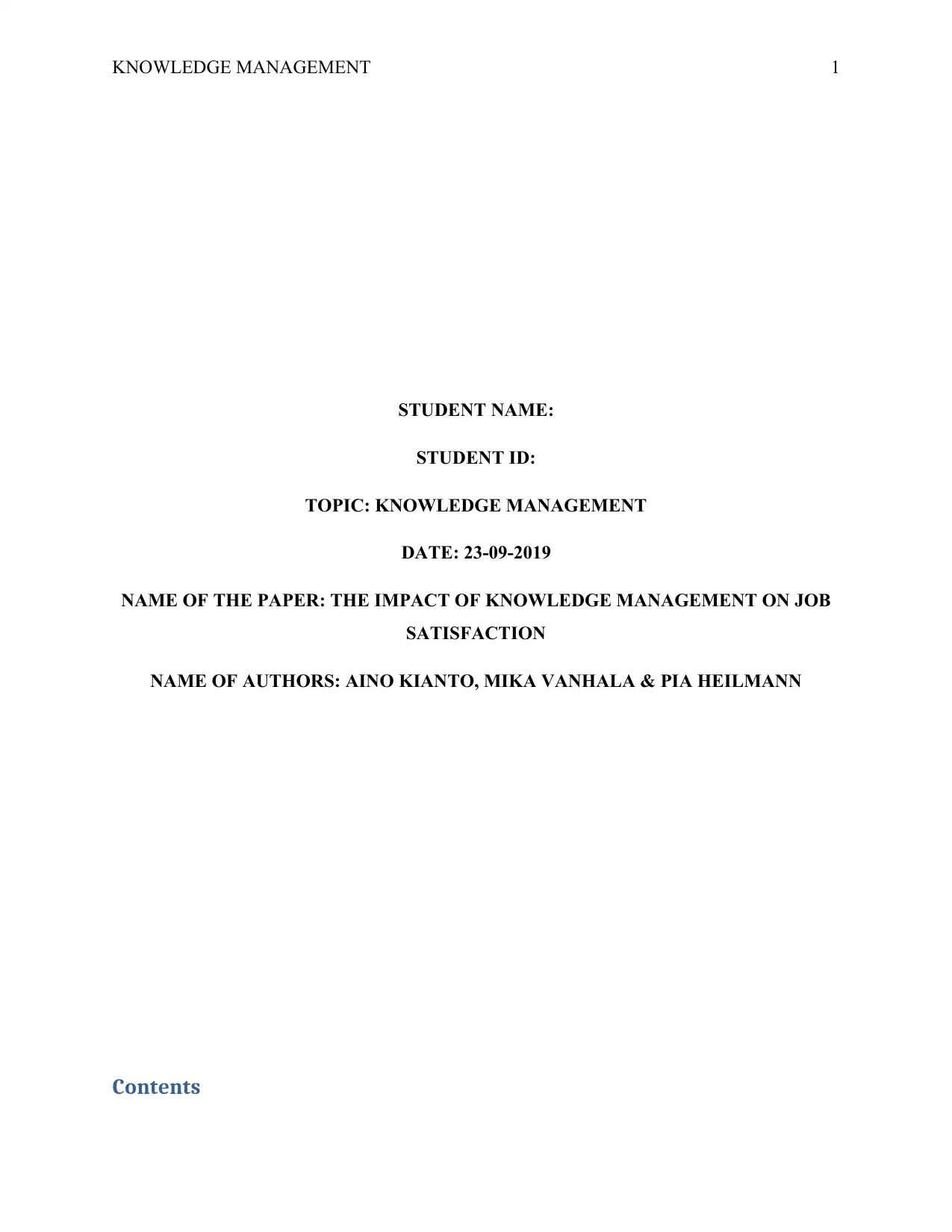
KNOWLEDGE MANAGEMENT 1
STUDENT NAME:
STUDENT ID:
TOPIC: KNOWLEDGE MANAGEMENT
DATE: 23-09-2019
NAME OF THE PAPER: THE IMPACT OF KNOWLEDGE MANAGEMENT ON JOB
SATISFACTION
NAME OF AUTHORS: AINO KIANTO, MIKA VANHALA & PIA HEILMANN
Contents
STUDENT NAME:
STUDENT ID:
TOPIC: KNOWLEDGE MANAGEMENT
DATE: 23-09-2019
NAME OF THE PAPER: THE IMPACT OF KNOWLEDGE MANAGEMENT ON JOB
SATISFACTION
NAME OF AUTHORS: AINO KIANTO, MIKA VANHALA & PIA HEILMANN
Contents
Paraphrase This Document
Need a fresh take? Get an instant paraphrase of this document with our AI Paraphraser
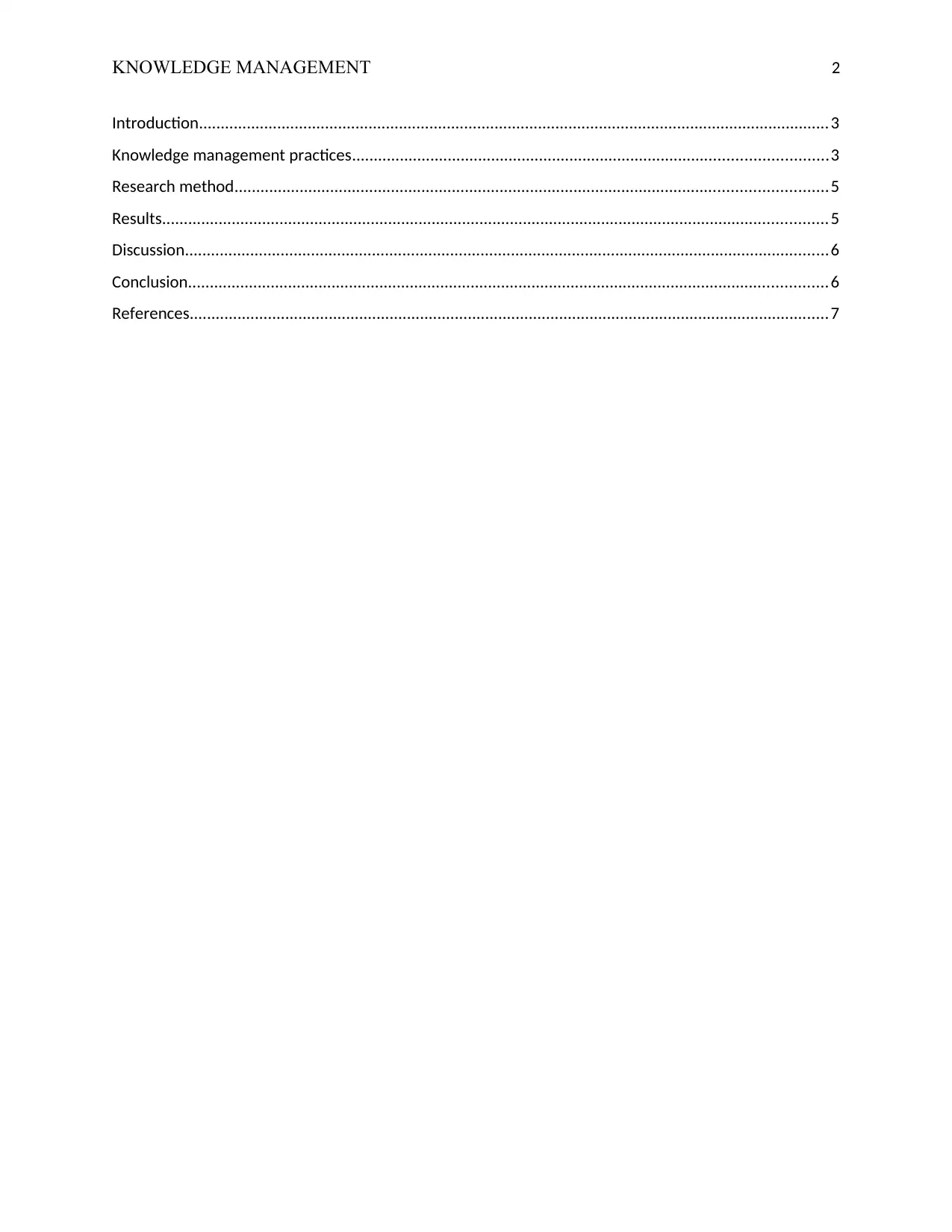
KNOWLEDGE MANAGEMENT 2
Introduction.................................................................................................................................................3
Knowledge management practices.............................................................................................................3
Research method........................................................................................................................................5
Results.........................................................................................................................................................5
Discussion....................................................................................................................................................6
Conclusion...................................................................................................................................................6
References...................................................................................................................................................7
Introduction.................................................................................................................................................3
Knowledge management practices.............................................................................................................3
Research method........................................................................................................................................5
Results.........................................................................................................................................................5
Discussion....................................................................................................................................................6
Conclusion...................................................................................................................................................6
References...................................................................................................................................................7
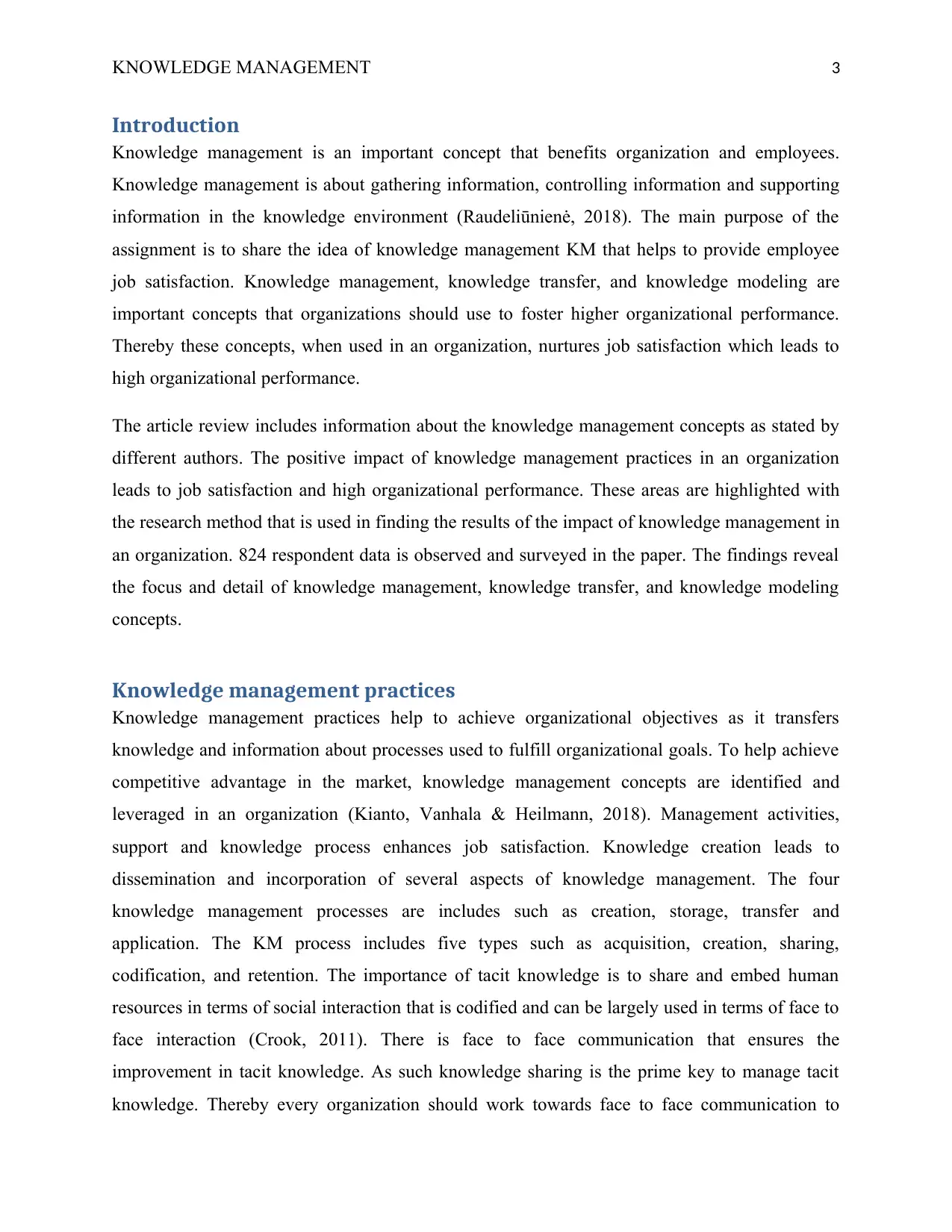
KNOWLEDGE MANAGEMENT 3
Introduction
Knowledge management is an important concept that benefits organization and employees.
Knowledge management is about gathering information, controlling information and supporting
information in the knowledge environment (Raudeliūnienė, 2018). The main purpose of the
assignment is to share the idea of knowledge management KM that helps to provide employee
job satisfaction. Knowledge management, knowledge transfer, and knowledge modeling are
important concepts that organizations should use to foster higher organizational performance.
Thereby these concepts, when used in an organization, nurtures job satisfaction which leads to
high organizational performance.
The article review includes information about the knowledge management concepts as stated by
different authors. The positive impact of knowledge management practices in an organization
leads to job satisfaction and high organizational performance. These areas are highlighted with
the research method that is used in finding the results of the impact of knowledge management in
an organization. 824 respondent data is observed and surveyed in the paper. The findings reveal
the focus and detail of knowledge management, knowledge transfer, and knowledge modeling
concepts.
Knowledge management practices
Knowledge management practices help to achieve organizational objectives as it transfers
knowledge and information about processes used to fulfill organizational goals. To help achieve
competitive advantage in the market, knowledge management concepts are identified and
leveraged in an organization (Kianto, Vanhala & Heilmann, 2018). Management activities,
support and knowledge process enhances job satisfaction. Knowledge creation leads to
dissemination and incorporation of several aspects of knowledge management. The four
knowledge management processes are includes such as creation, storage, transfer and
application. The KM process includes five types such as acquisition, creation, sharing,
codification, and retention. The importance of tacit knowledge is to share and embed human
resources in terms of social interaction that is codified and can be largely used in terms of face to
face interaction (Crook, 2011). There is face to face communication that ensures the
improvement in tacit knowledge. As such knowledge sharing is the prime key to manage tacit
knowledge. Thereby every organization should work towards face to face communication to
Introduction
Knowledge management is an important concept that benefits organization and employees.
Knowledge management is about gathering information, controlling information and supporting
information in the knowledge environment (Raudeliūnienė, 2018). The main purpose of the
assignment is to share the idea of knowledge management KM that helps to provide employee
job satisfaction. Knowledge management, knowledge transfer, and knowledge modeling are
important concepts that organizations should use to foster higher organizational performance.
Thereby these concepts, when used in an organization, nurtures job satisfaction which leads to
high organizational performance.
The article review includes information about the knowledge management concepts as stated by
different authors. The positive impact of knowledge management practices in an organization
leads to job satisfaction and high organizational performance. These areas are highlighted with
the research method that is used in finding the results of the impact of knowledge management in
an organization. 824 respondent data is observed and surveyed in the paper. The findings reveal
the focus and detail of knowledge management, knowledge transfer, and knowledge modeling
concepts.
Knowledge management practices
Knowledge management practices help to achieve organizational objectives as it transfers
knowledge and information about processes used to fulfill organizational goals. To help achieve
competitive advantage in the market, knowledge management concepts are identified and
leveraged in an organization (Kianto, Vanhala & Heilmann, 2018). Management activities,
support and knowledge process enhances job satisfaction. Knowledge creation leads to
dissemination and incorporation of several aspects of knowledge management. The four
knowledge management processes are includes such as creation, storage, transfer and
application. The KM process includes five types such as acquisition, creation, sharing,
codification, and retention. The importance of tacit knowledge is to share and embed human
resources in terms of social interaction that is codified and can be largely used in terms of face to
face interaction (Crook, 2011). There is face to face communication that ensures the
improvement in tacit knowledge. As such knowledge sharing is the prime key to manage tacit
knowledge. Thereby every organization should work towards face to face communication to
⊘ This is a preview!⊘
Do you want full access?
Subscribe today to unlock all pages.

Trusted by 1+ million students worldwide
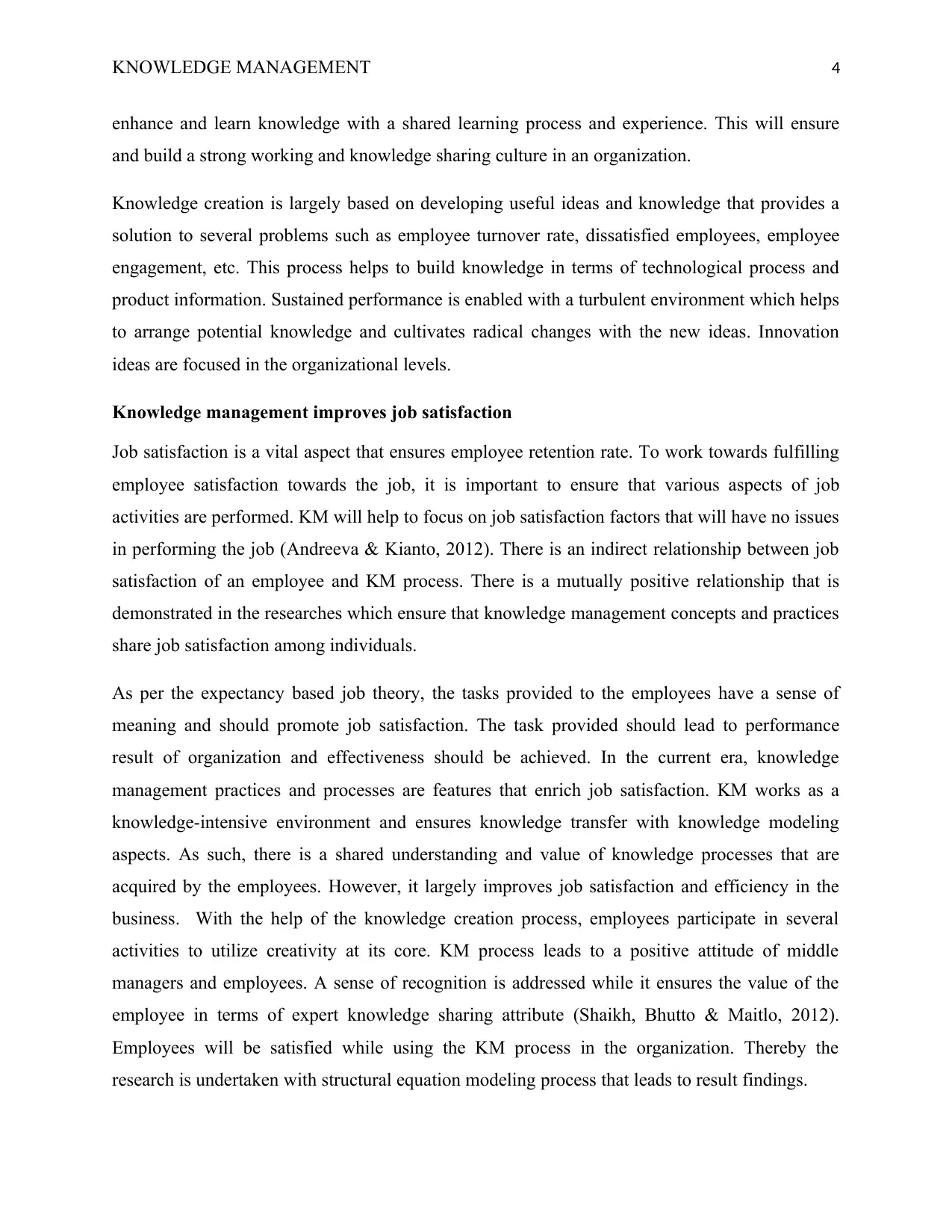
KNOWLEDGE MANAGEMENT 4
enhance and learn knowledge with a shared learning process and experience. This will ensure
and build a strong working and knowledge sharing culture in an organization.
Knowledge creation is largely based on developing useful ideas and knowledge that provides a
solution to several problems such as employee turnover rate, dissatisfied employees, employee
engagement, etc. This process helps to build knowledge in terms of technological process and
product information. Sustained performance is enabled with a turbulent environment which helps
to arrange potential knowledge and cultivates radical changes with the new ideas. Innovation
ideas are focused in the organizational levels.
Knowledge management improves job satisfaction
Job satisfaction is a vital aspect that ensures employee retention rate. To work towards fulfilling
employee satisfaction towards the job, it is important to ensure that various aspects of job
activities are performed. KM will help to focus on job satisfaction factors that will have no issues
in performing the job (Andreeva & Kianto, 2012). There is an indirect relationship between job
satisfaction of an employee and KM process. There is a mutually positive relationship that is
demonstrated in the researches which ensure that knowledge management concepts and practices
share job satisfaction among individuals.
As per the expectancy based job theory, the tasks provided to the employees have a sense of
meaning and should promote job satisfaction. The task provided should lead to performance
result of organization and effectiveness should be achieved. In the current era, knowledge
management practices and processes are features that enrich job satisfaction. KM works as a
knowledge-intensive environment and ensures knowledge transfer with knowledge modeling
aspects. As such, there is a shared understanding and value of knowledge processes that are
acquired by the employees. However, it largely improves job satisfaction and efficiency in the
business. With the help of the knowledge creation process, employees participate in several
activities to utilize creativity at its core. KM process leads to a positive attitude of middle
managers and employees. A sense of recognition is addressed while it ensures the value of the
employee in terms of expert knowledge sharing attribute (Shaikh, Bhutto & Maitlo, 2012).
Employees will be satisfied while using the KM process in the organization. Thereby the
research is undertaken with structural equation modeling process that leads to result findings.
enhance and learn knowledge with a shared learning process and experience. This will ensure
and build a strong working and knowledge sharing culture in an organization.
Knowledge creation is largely based on developing useful ideas and knowledge that provides a
solution to several problems such as employee turnover rate, dissatisfied employees, employee
engagement, etc. This process helps to build knowledge in terms of technological process and
product information. Sustained performance is enabled with a turbulent environment which helps
to arrange potential knowledge and cultivates radical changes with the new ideas. Innovation
ideas are focused in the organizational levels.
Knowledge management improves job satisfaction
Job satisfaction is a vital aspect that ensures employee retention rate. To work towards fulfilling
employee satisfaction towards the job, it is important to ensure that various aspects of job
activities are performed. KM will help to focus on job satisfaction factors that will have no issues
in performing the job (Andreeva & Kianto, 2012). There is an indirect relationship between job
satisfaction of an employee and KM process. There is a mutually positive relationship that is
demonstrated in the researches which ensure that knowledge management concepts and practices
share job satisfaction among individuals.
As per the expectancy based job theory, the tasks provided to the employees have a sense of
meaning and should promote job satisfaction. The task provided should lead to performance
result of organization and effectiveness should be achieved. In the current era, knowledge
management practices and processes are features that enrich job satisfaction. KM works as a
knowledge-intensive environment and ensures knowledge transfer with knowledge modeling
aspects. As such, there is a shared understanding and value of knowledge processes that are
acquired by the employees. However, it largely improves job satisfaction and efficiency in the
business. With the help of the knowledge creation process, employees participate in several
activities to utilize creativity at its core. KM process leads to a positive attitude of middle
managers and employees. A sense of recognition is addressed while it ensures the value of the
employee in terms of expert knowledge sharing attribute (Shaikh, Bhutto & Maitlo, 2012).
Employees will be satisfied while using the KM process in the organization. Thereby the
research is undertaken with structural equation modeling process that leads to result findings.
Paraphrase This Document
Need a fresh take? Get an instant paraphrase of this document with our AI Paraphraser
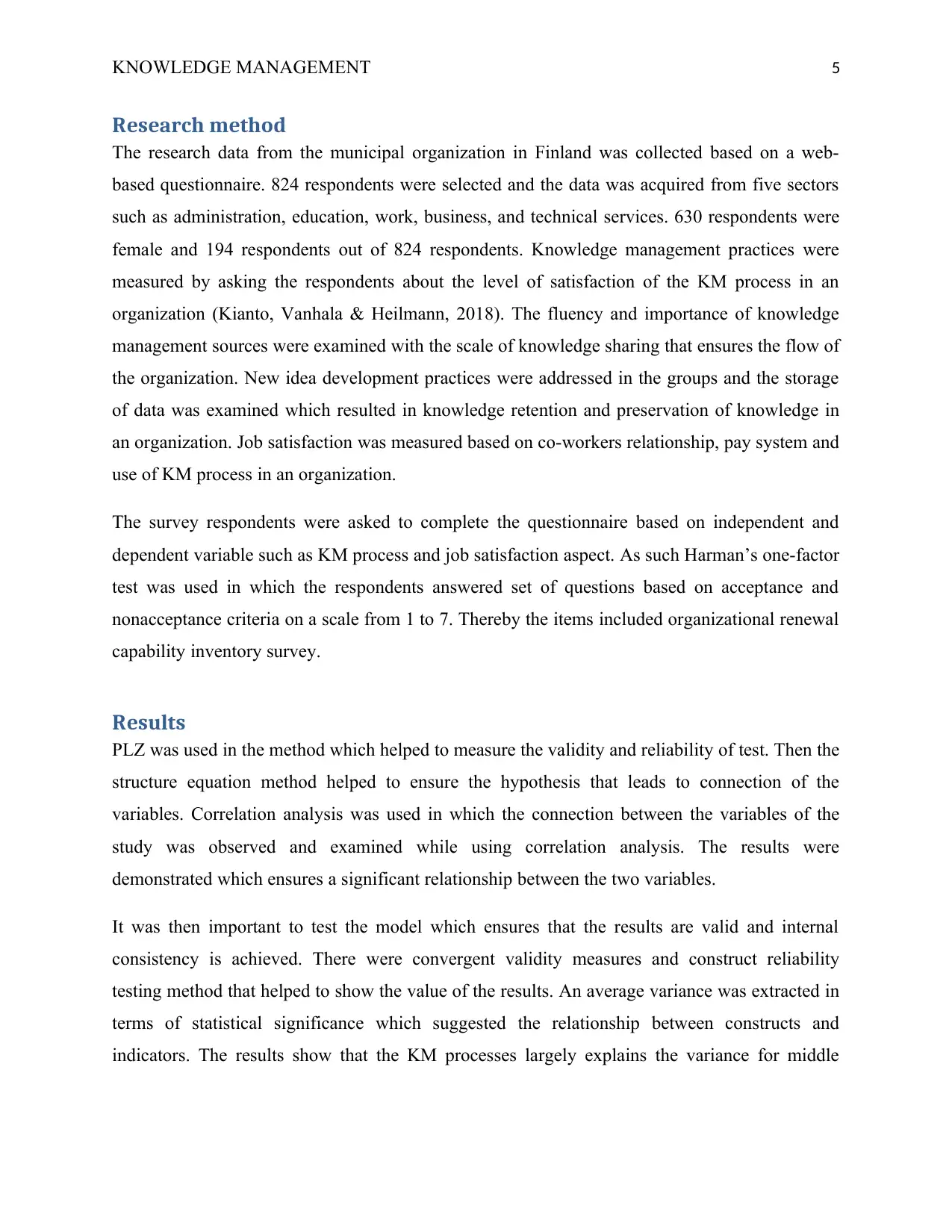
KNOWLEDGE MANAGEMENT 5
Research method
The research data from the municipal organization in Finland was collected based on a web-
based questionnaire. 824 respondents were selected and the data was acquired from five sectors
such as administration, education, work, business, and technical services. 630 respondents were
female and 194 respondents out of 824 respondents. Knowledge management practices were
measured by asking the respondents about the level of satisfaction of the KM process in an
organization (Kianto, Vanhala & Heilmann, 2018). The fluency and importance of knowledge
management sources were examined with the scale of knowledge sharing that ensures the flow of
the organization. New idea development practices were addressed in the groups and the storage
of data was examined which resulted in knowledge retention and preservation of knowledge in
an organization. Job satisfaction was measured based on co-workers relationship, pay system and
use of KM process in an organization.
The survey respondents were asked to complete the questionnaire based on independent and
dependent variable such as KM process and job satisfaction aspect. As such Harman’s one-factor
test was used in which the respondents answered set of questions based on acceptance and
nonacceptance criteria on a scale from 1 to 7. Thereby the items included organizational renewal
capability inventory survey.
Results
PLZ was used in the method which helped to measure the validity and reliability of test. Then the
structure equation method helped to ensure the hypothesis that leads to connection of the
variables. Correlation analysis was used in which the connection between the variables of the
study was observed and examined while using correlation analysis. The results were
demonstrated which ensures a significant relationship between the two variables.
It was then important to test the model which ensures that the results are valid and internal
consistency is achieved. There were convergent validity measures and construct reliability
testing method that helped to show the value of the results. An average variance was extracted in
terms of statistical significance which suggested the relationship between constructs and
indicators. The results show that the KM processes largely explains the variance for middle
Research method
The research data from the municipal organization in Finland was collected based on a web-
based questionnaire. 824 respondents were selected and the data was acquired from five sectors
such as administration, education, work, business, and technical services. 630 respondents were
female and 194 respondents out of 824 respondents. Knowledge management practices were
measured by asking the respondents about the level of satisfaction of the KM process in an
organization (Kianto, Vanhala & Heilmann, 2018). The fluency and importance of knowledge
management sources were examined with the scale of knowledge sharing that ensures the flow of
the organization. New idea development practices were addressed in the groups and the storage
of data was examined which resulted in knowledge retention and preservation of knowledge in
an organization. Job satisfaction was measured based on co-workers relationship, pay system and
use of KM process in an organization.
The survey respondents were asked to complete the questionnaire based on independent and
dependent variable such as KM process and job satisfaction aspect. As such Harman’s one-factor
test was used in which the respondents answered set of questions based on acceptance and
nonacceptance criteria on a scale from 1 to 7. Thereby the items included organizational renewal
capability inventory survey.
Results
PLZ was used in the method which helped to measure the validity and reliability of test. Then the
structure equation method helped to ensure the hypothesis that leads to connection of the
variables. Correlation analysis was used in which the connection between the variables of the
study was observed and examined while using correlation analysis. The results were
demonstrated which ensures a significant relationship between the two variables.
It was then important to test the model which ensures that the results are valid and internal
consistency is achieved. There were convergent validity measures and construct reliability
testing method that helped to show the value of the results. An average variance was extracted in
terms of statistical significance which suggested the relationship between constructs and
indicators. The results show that the KM processes largely explains the variance for middle
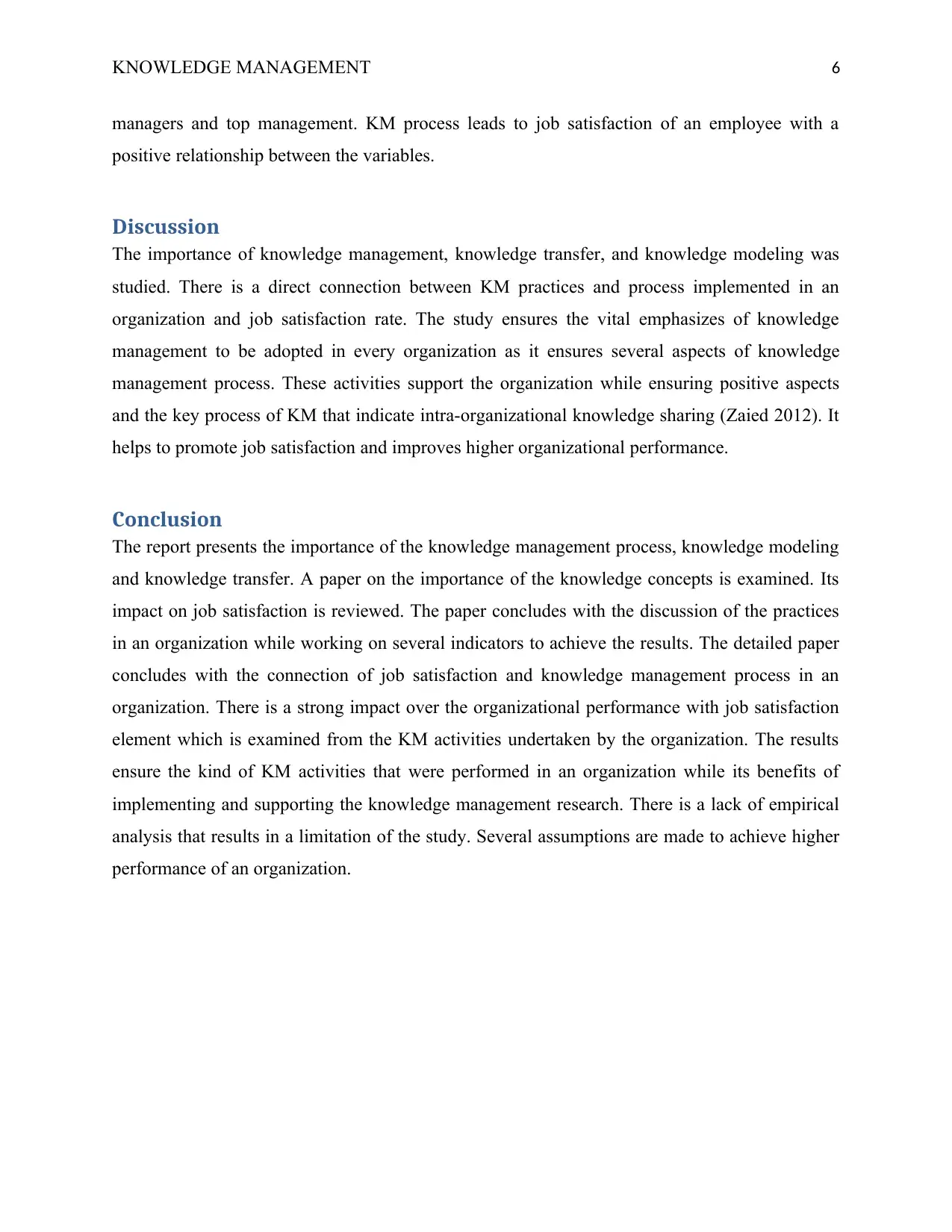
KNOWLEDGE MANAGEMENT 6
managers and top management. KM process leads to job satisfaction of an employee with a
positive relationship between the variables.
Discussion
The importance of knowledge management, knowledge transfer, and knowledge modeling was
studied. There is a direct connection between KM practices and process implemented in an
organization and job satisfaction rate. The study ensures the vital emphasizes of knowledge
management to be adopted in every organization as it ensures several aspects of knowledge
management process. These activities support the organization while ensuring positive aspects
and the key process of KM that indicate intra-organizational knowledge sharing (Zaied 2012). It
helps to promote job satisfaction and improves higher organizational performance.
Conclusion
The report presents the importance of the knowledge management process, knowledge modeling
and knowledge transfer. A paper on the importance of the knowledge concepts is examined. Its
impact on job satisfaction is reviewed. The paper concludes with the discussion of the practices
in an organization while working on several indicators to achieve the results. The detailed paper
concludes with the connection of job satisfaction and knowledge management process in an
organization. There is a strong impact over the organizational performance with job satisfaction
element which is examined from the KM activities undertaken by the organization. The results
ensure the kind of KM activities that were performed in an organization while its benefits of
implementing and supporting the knowledge management research. There is a lack of empirical
analysis that results in a limitation of the study. Several assumptions are made to achieve higher
performance of an organization.
managers and top management. KM process leads to job satisfaction of an employee with a
positive relationship between the variables.
Discussion
The importance of knowledge management, knowledge transfer, and knowledge modeling was
studied. There is a direct connection between KM practices and process implemented in an
organization and job satisfaction rate. The study ensures the vital emphasizes of knowledge
management to be adopted in every organization as it ensures several aspects of knowledge
management process. These activities support the organization while ensuring positive aspects
and the key process of KM that indicate intra-organizational knowledge sharing (Zaied 2012). It
helps to promote job satisfaction and improves higher organizational performance.
Conclusion
The report presents the importance of the knowledge management process, knowledge modeling
and knowledge transfer. A paper on the importance of the knowledge concepts is examined. Its
impact on job satisfaction is reviewed. The paper concludes with the discussion of the practices
in an organization while working on several indicators to achieve the results. The detailed paper
concludes with the connection of job satisfaction and knowledge management process in an
organization. There is a strong impact over the organizational performance with job satisfaction
element which is examined from the KM activities undertaken by the organization. The results
ensure the kind of KM activities that were performed in an organization while its benefits of
implementing and supporting the knowledge management research. There is a lack of empirical
analysis that results in a limitation of the study. Several assumptions are made to achieve higher
performance of an organization.
⊘ This is a preview!⊘
Do you want full access?
Subscribe today to unlock all pages.

Trusted by 1+ million students worldwide
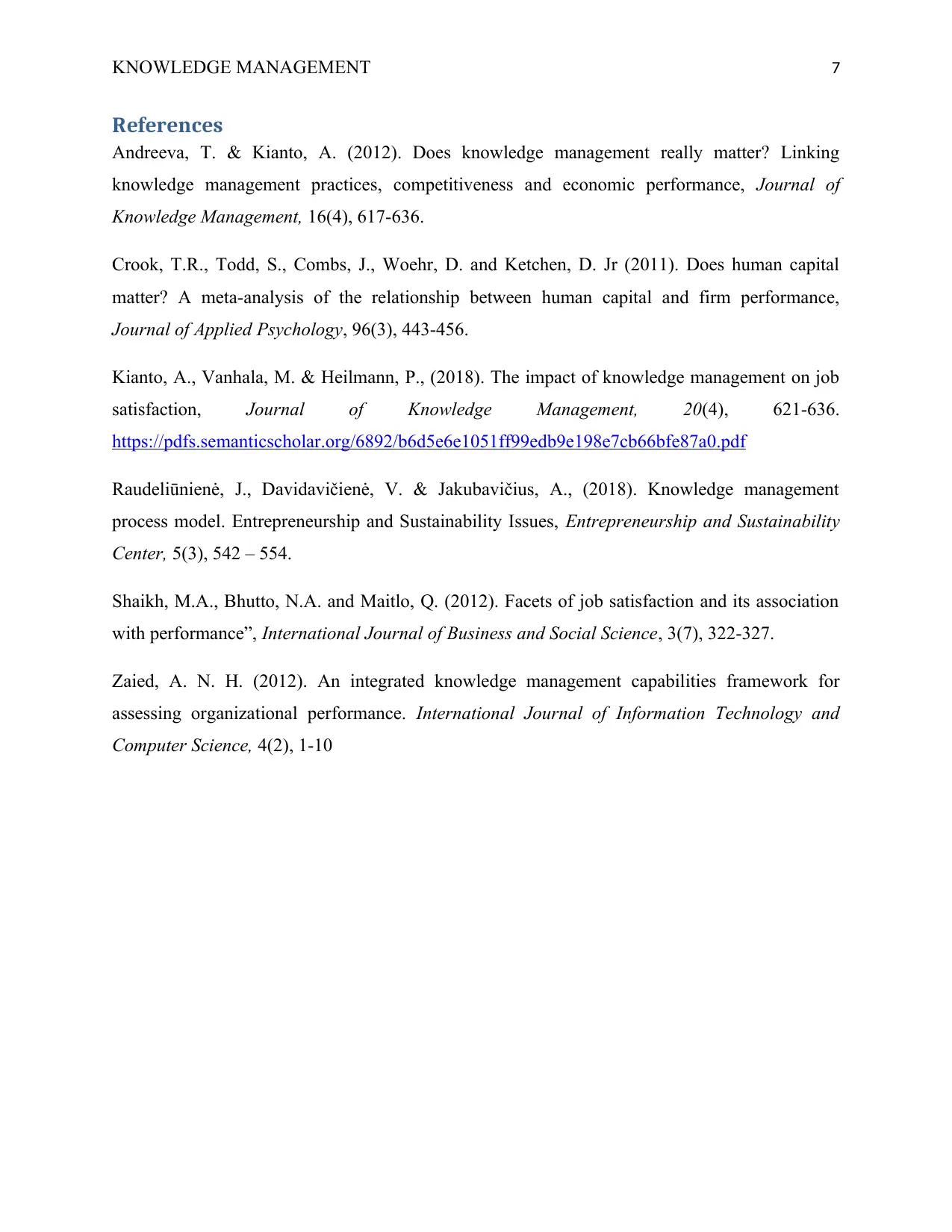
KNOWLEDGE MANAGEMENT 7
References
Andreeva, T. & Kianto, A. (2012). Does knowledge management really matter? Linking
knowledge management practices, competitiveness and economic performance, Journal of
Knowledge Management, 16(4), 617-636.
Crook, T.R., Todd, S., Combs, J., Woehr, D. and Ketchen, D. Jr (2011). Does human capital
matter? A meta-analysis of the relationship between human capital and firm performance,
Journal of Applied Psychology, 96(3), 443-456.
Kianto, A., Vanhala, M. & Heilmann, P., (2018). The impact of knowledge management on job
satisfaction, Journal of Knowledge Management, 20(4), 621-636.
https://pdfs.semanticscholar.org/6892/b6d5e6e1051ff99edb9e198e7cb66bfe87a0.pdf
Raudeliūnienė, J., Davidavičienė, V. & Jakubavičius, A., (2018). Knowledge management
process model. Entrepreneurship and Sustainability Issues, Entrepreneurship and Sustainability
Center, 5(3), 542 – 554.
Shaikh, M.A., Bhutto, N.A. and Maitlo, Q. (2012). Facets of job satisfaction and its association
with performance”, International Journal of Business and Social Science, 3(7), 322-327.
Zaied, A. N. H. (2012). An integrated knowledge management capabilities framework for
assessing organizational performance. International Journal of Information Technology and
Computer Science, 4(2), 1-10
References
Andreeva, T. & Kianto, A. (2012). Does knowledge management really matter? Linking
knowledge management practices, competitiveness and economic performance, Journal of
Knowledge Management, 16(4), 617-636.
Crook, T.R., Todd, S., Combs, J., Woehr, D. and Ketchen, D. Jr (2011). Does human capital
matter? A meta-analysis of the relationship between human capital and firm performance,
Journal of Applied Psychology, 96(3), 443-456.
Kianto, A., Vanhala, M. & Heilmann, P., (2018). The impact of knowledge management on job
satisfaction, Journal of Knowledge Management, 20(4), 621-636.
https://pdfs.semanticscholar.org/6892/b6d5e6e1051ff99edb9e198e7cb66bfe87a0.pdf
Raudeliūnienė, J., Davidavičienė, V. & Jakubavičius, A., (2018). Knowledge management
process model. Entrepreneurship and Sustainability Issues, Entrepreneurship and Sustainability
Center, 5(3), 542 – 554.
Shaikh, M.A., Bhutto, N.A. and Maitlo, Q. (2012). Facets of job satisfaction and its association
with performance”, International Journal of Business and Social Science, 3(7), 322-327.
Zaied, A. N. H. (2012). An integrated knowledge management capabilities framework for
assessing organizational performance. International Journal of Information Technology and
Computer Science, 4(2), 1-10
1 out of 7
Related Documents
Your All-in-One AI-Powered Toolkit for Academic Success.
+13062052269
info@desklib.com
Available 24*7 on WhatsApp / Email
![[object Object]](/_next/static/media/star-bottom.7253800d.svg)
Unlock your academic potential
Copyright © 2020–2025 A2Z Services. All Rights Reserved. Developed and managed by ZUCOL.





